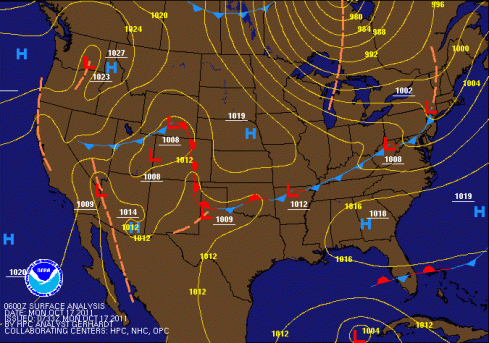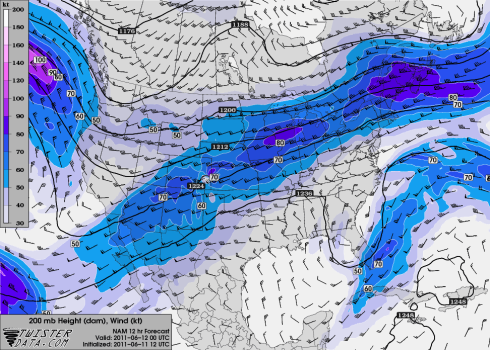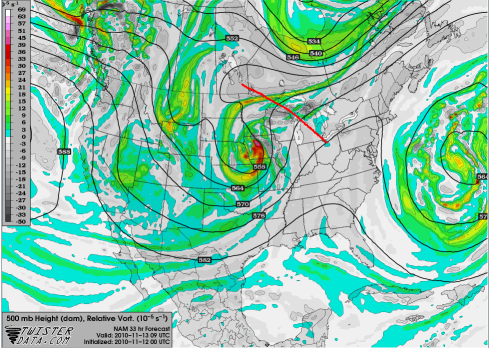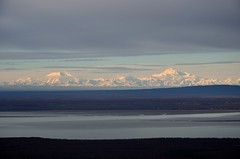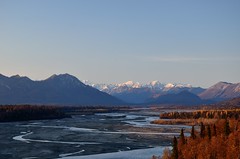In terms of the unstable stratification of a fluid, different types of cyclogenesis can manifest itself in the mid-latitude westerlies. It is the forecasters responsibility to understand what is happening from a full “3-Dimensional” aspect. Our atmosphere does not work on 2-D surfaces or only at 500 hpa, 700 hpa, 850 hpa, etc. A continuous spectrum of differing types of cyclogenesis exists with examples including open wave upper disturbances over intense low level baroclinic zones, wave deamplification, deep tropospheric cyclogenesis over moist low level baroclinic zones, etc. Understanding the type of “potential” cyclogenesis is a key to understanding how the eventual baroclinic system will develop. Models are not the answer–they are just the guidance tool to provide the meteorologist with the details needed to assess the state of the atmosphere. Let’s move on.
NOTE: All images below can be enlarged by clicking them.
A tropospheric deep, “vertically stacked” cyclone is currently rapidly developing over the northern plains. As per usual, this type of cyclogenesis was not particularly well modeled by the numerical guidance as it is deepened faster and stronger than progged. The resultant surface low is much farther west and “bent-back” into the low level thermal gradient.


12Z GFS model progs from a couple days ago at 500 hpa with the forecast time of 18Z Saturday:

And the surface pressure/theta-e fields:

Compare to the current 18Z analysis at 500 hpa:


The European 48 HR forecast (left panel is the ensemble mean, right is the operational) performed better, but it was also too weak and was an open wave aloft.

Which shows up much better in the surface fields. 48 hr ECMWF forecast:

12Z analysis today:


Note how the low is “bent-back” and much farther W than progged with a deeper surface low and stronger cold side gradient. These type of forecast changes have significant effects on the eventual forecast. If the forecaster simply “responds” to each model forecast as it continually changes, then their forecast will never be right if the models are constantly playing catch-up to observations! Most importantly–the high impact effects of the storm won’t be relayed to the public in a timely manner.
Watch the progression of the 54 HR GFS forecast to the eventual analysis at 18Z Saturday. Note how the position of the low changes from southern Canada north of the Great Lakes to central North Dakota . Also note how much deeper the surface low is as well as the strength of the mass fields owing to the increased pressure gradient (as well as increased vertical momentum transport/mixing). This is all in a period of 2.5 days of GFS model runs (dProg/dT):

If the forecaster were to simply take each individual GFS forecast verbatim, the forecast would have been a miserable bust with a large number of “jumps” in the forecast. Both are very undesirable.
In previous blogs I took the time to explain baroclinic cyclogenesis from a standpoint of Quasigeostrophic Theory. However, in the past 5 months, I have forced myself to learn Isentropic Potential Vorticity, and I have learned its great utility in the forecast process as a result. I am still learning IPV, but I have seen the high usability of IPV in terms of the type of “cyclogenesis” as it is a more “natural” way to view the 3-Dimensional atmosphere and the resultant flows of baroclinic systems.
Isentropic Potential Vorticity is a pretty broad topic which would take far too long to even try and explain, but what IPV does is essentially explain the “dynamical tropopause” based on potential vorticity identified by the PV gradient on isentropes where PV (image courtesy of RAMMB) is defined as

with units of 10-6 m-2 s-1 K kg-1.
In other words, PV is the mathematical dot product of isentropic absolute vorticity and static stability. PV is conserved and the quantity can only be changed by changes in static stability and/or friction. The beauty of IPV is the “invertibility principle” researched and discovered by Hoskins (Hoskins, B.J., M.E. McIntyre, and A.W. Robertson, 1985: On the use and significance of isentropic potential vorticity maps.) The invertibility principle itself is a rather long and complicated mathematical formulation, but in short, it allows for the calculations of all major meteorological quantities such as winds, heights, temperature, etc. as well as the plotting of PV maps on various surfaces (isentropes, pressure surfaces, etc.) One variation on the use of Potential Vorticity is the “Dynamic Tropopause”, or DT. Typically the Dynamic Tropopause is defined as the 1.5/2 PV surface where PVU’s are “Potential Vorticity Units” (although it can vary between 1-5 PVU’s). This is typically the “zone” between tropospheric and stratospheric air. A “positive” PV Anomaly can therefore be defined as a local minimum in the tropopause and an area of cyclonic vorticity. Morgan and Gammon (see references below) discuss the usage of the dynamic tropopause,
“This analysis (here referred to as a tropopause map) exploits the rather simple distribution of tropospheric PV: as will be demonstrated in the next section, isentropic gradients of PV are concentrated at the tropopause. Tropopause maps are a compact way to represent this distribution. Thus, the essential character of the upper-tropospheric PV may be depicted on a single chart, rather than several isentropic maps.”
A deep vertical PV anomaly aloft and a strong potential temperature (theta-e) gradient in the low levels can be favored regions of deep and rapid cyclogenesis owing to a number of factors including moist latent heat release, stratospheric intrusions/tropopause folding, and upper level frontogenesis. This characterization of the baroclinic atmosphere is referred to as the “Eady model representation”, and it should be noted here that PV usage does not describe the baroclinic atmosphere differently than the various forms of the Quasigeostrophic set of equations, it just uses a different approach (all rely on the N-S equations).
I have found a mixture of the Quasigeostrophic “thinking” combined with “PV thinking” to be optimal in assessing the baroclinic environment and the potential types of cyclogenesis. For instance, one may want to assess the potential for a deep stratospheric intrusion (a deep vertical PV anomaly)/upper level cold front to interact with a low level baroclinic zone which can incite rapid positive feedback cyclogenesis under the right conditions. Assessing the Dynamic Tropopause in such situations is crucial in understanding this potential for deep tropospheric cyclogenesis. It can be shown that a deep DT/upper level cold front will enhance the vertical wind field aloft. Consider the thermal wind equation:

which essentially states that a deep vertical layer of air consisting of a strong horizontal thermal gradient through the depth results in increasing geostrophic winds with height.
Think of an upper level cold front cross section:

This is one way to “visualize” the 3-D atmosphere is through the superpositioning of a strong upper level cold front/DT/PV anomaly over a low level baroclinic zone, rapidly resulting in an increase in the vertical depth of the baroclinic zone as the upper anomaly progresses over a low level baroclinic zone. It becomes obvious that jet streaks are an atmospheric response to propagating PV anomalies in the upper atmosphere. Therefore the upper level wind fields are strongly influenced by PV anomalies, and the resultant divergent mesoscale jet circulations that develop are simply a response to the anomaly. This is why rapidly “bombing” surface lows often feature strongly curved and/or coupled jet streaks aloft.
The February 1, 2011 “Groundhogs Day Blizzard” and the coupled jet streak and strongly divergent mesoscale circulation:

400-250 Potential Vorticity:


Also note the WV imagery and the direct “coupling” of the low level deep, moist convection “feeding” directly into the divergent portion of the upper level jet streak. This is a classic feature in rapidly developing storms, and it can be considered the “warm conveyor belt” typical in synoptic storms. Once again, it can be shown with PV thinking that low level and deep, moist baroclinic zones with a deep upper level PV anomaly can incite rapid and deep cyclogenesis driven strongly by moist latent heat release and decreased static stability.

It has been studied and shown in numerous studies that the release of latent heat in the low levels can have an enormous contribution to the omega equation vertical forcing (sometimes greatly larger than all the other terms combined):

Often times the influence of diabatic effects (red arrow) is often considered small (and all together dropped) from the omega equation. However, it has been shown to play a significant role in rapid deepening and can strongly influence potential self-development/mutual development/positive feedback effects on the cyclogenesis process (for more information on self devolopment/rapid cyclogenesis, see : https://pantherfile.uwm.edu/roebber/www/pubs/R93.pdf). Also note the static stability parameter (in green…the sigma characters) plays a prominent role in all the major forcing terms of the omega equation. In other words, low static stability plays a major role in rapid development (hence why the most intense lows often have very warm and moist warm sectors. Also note PV thinking/Eady model development also make use of low level static stability contributions. http://journals.ametsoc.org/doi/pdf/10.1175/1520-0493(1986)114%3C1019%3ATPIOUU%3E2.0.CO%3B2
Note the deep Dynamic Tropopause and the very high values of 925 theta-e for the February 1, 2011 event. One can imagine how the overlaying of a cold anomaly over a warm and moist baroclinic zone can result in extremely low static stability (and possibly static instability):

It should come as no surprise, looking at the model data, that the Groundhogs Blizzard eventually “bombed” faster than any model projections which had profound effects on the track of the low, the resultant mass fields/wind fields, and the distribution of the precipitation. It should be noted this event had “several” model solutions ranging from a very weak and “flat” track with the NAM and a moderately NW curving “non-linearly” developing low (GFS/ECMWF) to a strongly curved and intensely bombing low (RGEM). Understanding model bias and understanding the situation at hand is crucial to understanding the forecast potential. In this case, the usually “amped” NAM was being influenced significantly by “convective feedback” owing to “overcooked” convection and the mass release of unrealistic latent heat into the upper troposphere. This warming of the upper levels crippled the model dynamic fields resulting in the unusual “flat” and weak track the NAM developed.
Hard to see here, but the NAM progged a “flat” and weak surface low track–much weaker than all other guidance. Note the very high values of anticyclonic vorticity ahead of the 500 hpa shortwave–a response to the significant deep, moist convection the NAM was developing ahead of the wave. Also note in the last frame the eastward “jump” the low takes–a sign of the significant issues the NAM was having in terms of the development of this system. In reality–the low tracked much farther NW and was much more intense than the NAM projected, and the NAM remained too weak through the entire event.

In reality, as shown above, deep convection can play a strong role in rapid development owing to a strongly divergent mesoscale jet circulation and a direct “coupling” of the low level deep, moist convection feeding into the circulation.

As will be shown in later posts, many different types of cyclogenesis occur spanning a continuous spectrum from deep and bombing non-linear cyclogenesis to steady-state open waves (shallow cyclogenesis) and the resultant low level cyclogenesis.
A good example of shallow cyclogenesis is a classic Alberta Clipper with an open wave aloft and strong cyclogenesis in the low levels–a result of the “shallow” nature of the PV maxes aloft and shallow but intense low level baroclinic zones. Also note the rather “steady” linear development of the cyclone (compare to a deep tropospheric bombing cyclone). This is typical in Alberta Clippers owing both to the aforementioned shallow PV anomaly but also due to the significant lack of moist processes (latent heat release in the low levels).
Click the link for an animation of a classic Alberta Clipper developing from Canada to the East Coast:
http://www.meteo.psu.edu/~gadomski/NARR/2007/us0222j3.php
Getting back to the current northern plains storm, why does all this matter?
Note the GFS forecast from the 28th of April, 2011 at 12Z (same as the first plot above with the weak overall solution) featured a deep PV anomaly plotted on pressure surfaces for the 24 hour forecast (note the scale on right–dark blue is a deeper PV anomaly–and we are referencing the anomaly over the intermountain W):

There was significant potential for deep cyclogenesis given the warm sector in place even though the eventual GFS forecast was weak (seen above). How does this play into the forecast process? Does the forecaster take the model verbatim and run with it? If one looked at surface fields alone, it would not be in any way obvious anything special was going to happen. However, the forecaster had other available guidance (the ECMWF…and the Canadian to a degree) suggesting potential for a more significant event (let us ignore the GFS ensemble suite for now to use this as a case example). Understanding the type of cyclogenesis is absolutely crucial to being able to identify where the model solutions may potentially “bust”. Moreover, using such a “dynamic” assessment of the atmosphere, one can apply model bias as well as forecaster “experience” in such a situation to add significant benefit to the forecast. Models are tools–they are NOT the solution, and using models as solutions only will result in bad forecasts and very significant busted forecasts during high impact events. Let us continue.
By the 29th of April at 00Z (12 hours later), the 12 hour forecast panel suggests an even farther S and slightly broader DT.

The result, owing to stronger cross barrier flow across the Rockies, was an increase in low level warm air advection across the warm sector due to increased lee side troughing (which can be described through the conservation of potential vorticity as well as through quasigeostrophic theory by setting a lower boundary condition and deriving a new set of equations).
Note the warm air surging off the high plains into KS/OK (and how much stronger it is in the 29th April, 12 Z forecast):

And explained through the Quasigeostrophic Chi equation, increased low level warm air advection (which decreases with height aloft) will drive height rises aloft:

Which I explained much more thoroughly in this post: https://jasonahsenmacher.wordpress.com/2010/11/12/centralnorthern-plains-cyclone-event-1112-142010/
Note the upper level height response manifested in increased ridging aloft over MN and into Canada (500 hpa vorticity):

By this time, it was clear to the forecaster that the potential for tropospheric deep cyclogenesis owing to the deep PV anomaly aloft, the warm anomaly in the low levels (high theta values which corresponds to high PV), and the southern trend of the upper anomaly which resulted in even richer low level warm air advection (thus strengthening the low level baroclinic zone (and the corresponding PV anomaly in the low levels).
Notice how the guidance was rapidly deepening the low/mid levels with time with the 12Z GFS forecast on the 29th (500 hpa vorticity). Also note, in this situation, the 500 hpa level is not indicative of the region of mass divergence. In other words, 500 hpa is typically the atmospheric pressure level often evaluated for the placement of upper level waves since the average level of non-divergence (LND) is 550-600 hpa. In this case, the LND would likely be well above 500 hpa into the upper troposphere. Care must be taken when evaluating upper waves as 500 hpa alone may not be representative.

Note how the superposition of the upper anomaly over the warm anomaly in the low levels results in deep and rapid cyclogenesis/height falls and the “creation” of cold air in the low levels (watch the 925 theta-e fields with time).


This can be explained through the “interaction” between the positive PV anomalies in the upper and lower levels and the stretching of vorticity through the vertical.

It is also a result of the “descent” of the upper level cold front into the lower levels of the atmosphere–and as shown earlier–can be tied directly to an increase in the upper level wind fields. From this point, classic “mutual development”/positive feedback cyclogenesis occurs. Deep height falls and cyclogenesis results in increased wind fields and mass transport of warm air into the warm sector as well as the development of a TROWAL as warm air is advected onto the backside of the upper low and above the descending upper level cold front. According to the QG Omega equation, WAA will result in synoptic ascent, but this WAA through the warm sector also increases the baroclinity farther northward. According to the thermal wind equation–an increasing thermal gradient in the horizontal results in stronger wind fields aloft. As a result, a distinct jet coupling aloft develops which results in increased values of divergence and a stronger warm conveyor belt which drives stronger WAA which then supports greater synoptic ascent and faster low level pressure falls/mass convergence. Horizontal confluence in the low levels increases frontogenesis values (horizontal deformation contribution)


and mesoscale ascent along the front where yellow is the axis of dilatation. In certain cases–it has been shown that precipitation processes/moist processes associated with ascent along the front can contribute significantly to vertical forcing and associated low level pressure falls owing to latent heat release.

Note how the jet coupling aloft develops (the secondary jet especially in Canada) in response to the increasing WAA into Canada (increasing low level warm front as well) and subsequent increase in the horizontal thermal gradient:

By this point warm air advection ascent associated with the TROWAL and increasing curved jet level divergence results in a bent back surface low with a strong cold side gradient:

This is classic self development/positive feedback cyclogenesis, and there are multiple mechanisms (besides the one mentioned above) that can create positive feedback cyclogenesis.
The effect of a descending upper level cold front and deep tropospheric cyclogenesis also tends to result in very efficient mixing through contributions of strong vertical descent over the cold sector and the destruction of inversions. This can have significant results on the overall wind fields in the low levels.
Note the deep mixed layer and extreme mixing potential in the May 1, 00Z KRAP sounding:

Positive feedback cyclogenesis can occur in many ways, but this is one example of where mutual development strongly driven by intense WAA can result in rapid cyclogenesis.
It is typical in these situations for models to be in constant “catch-up” mode and they will potentially be adjusting all the way to the final event. Note the NAM surface fields from the day 2 forecast until analysis at 18Z April 31 (especially note the much slower/farther W track and the stronger mass fields):

While numerical models are amazing tools, the complex statistical data assimilation systems are not capable of responding to rapidly changing observations once positive feedback begins. Moreover, models are influenced heavily by the previous analysis field, so under a situation where there is a “cascading” effect, models will always be “behind”–sometimes multiple iterations behind reality. It is the forecasters responsibility to assess this potential as it can have massive impacts on the eventual forecast–as seen here.
The eventual storm deepened to 987 hpa, well below the 2 day model progs, and even below the current model analyses. The low was farther west into the cold air than progged by the guidance, and the storm moved much slower.



Wind gusts at Buffalo, SD were in excess of 75 MPH and many locations saw sustained winds of over 50 MPH. Locations in ND saw significant life threatening blizzard conditions for a prolonged period of time. Some locations saw over one foot of snow with 60+ MPH winds within the blizzard locations.
It is quite obvious that models are not the solution–they are only a tool in assessing the atmosphere. Having a strong understanding of the processes at work is an absolute must, and understanding how numerical models simulate the atmosphere is crucial in understanding their weaknesses as well as biases. Potential Vorticity thinking is just another tool available to the forecaster which can significantly aid in assessing atmospheric processes, and as I continue to learn, I hope to add more posts in the future as well as expand on PV/IPV topics.
As always, meteorology is a beautiful and wonderful thing when it makes sense. Dynamic assessment allows the forecaster to “view” atmospheric flow in a more natural way. Having this understanding no longer makes us a slave to the numerical models, but it gives us the ability to not only see “potential” but to avoid big high impact forecast busts as well. Most importantly, it allows the forecaster to view the forecast from a different perspective. One can fill in the “details” in their head–and it gives them the ability to analyze the things that matter and disregard the things that really don’t mean much in the end (for instance–model derived isentropic ascent/descent and model vertical velocity fields)–an important quality in these days of “too much information” and busy forecast schedules. Knowing what to “track” and analyze and what influences baroclinic development will give the forecaster the ability to “see” potential for significant deviations in the model forecast or for things to be stronger/weaker than progged.
References:
http://onlinelibrary.wiley.com/doi/10.1034/j.1600-0870.1995.00124.x/pdf
http://journals.ametsoc.org/doi/abs/10.1175/1520-0493(1998)126%3C2555%3AUTMTDM%3E2.0.CO%3B2
http://journals.ametsoc.org/doi/abs/10.1175/2008JAS2921.1
http://journals.ametsoc.org/doi/pdf/10.1175/1520-0434(1988)003%3C0217%3ATROLHR%3E2.0.CO%3B2













